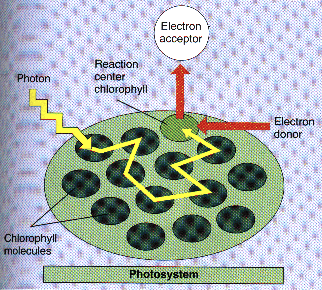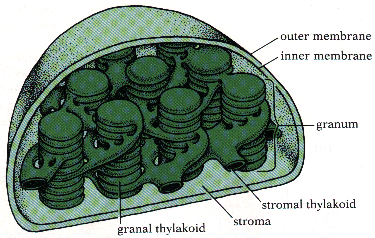Light Absorption Notes
Plants convert light energy into chemical (C-H bonds) energy of sugars.
6CO2 + 6H2O----------- C6H12O6 + 6O2
Sunlight is a mixture of different colored lights. Each color is a different
wavelength (400nm-750nm), & thus a different level of energy to be used.

Photosynthetic Plant Pigments: Chemicals that absorb light, & have electrons
that become energized. The energized electrons then are used to make ATP or
other energy carrier molecules.
Plant pigments are organized as photosystems (Pigments surrounding a central
chlorophyll a molecule....the reaction center). Each pigment absorbs a different
wavelength of light & transfers its energy to the reaction center which
in turns energizes an electron. The energized electron is then used elsewhere
to C-H bond energy in sugar.
 x
x
 Chloroplast:
plant cell organelle where photosynthesis occurs.
Chloroplast:
plant cell organelle where photosynthesis occurs.
2 parts to chloroplast:
a. Grana- Contains chlorophyll. Looks like coin stacks. Where light dependent
reactions occur.
b. Stroma- No chlorophyll. Surrounds grana. Where sugar is made. Where light
independent reactions occur.
Long & Slichter


 x
x Chloroplast:
plant cell organelle where photosynthesis occurs.
Chloroplast:
plant cell organelle where photosynthesis occurs.